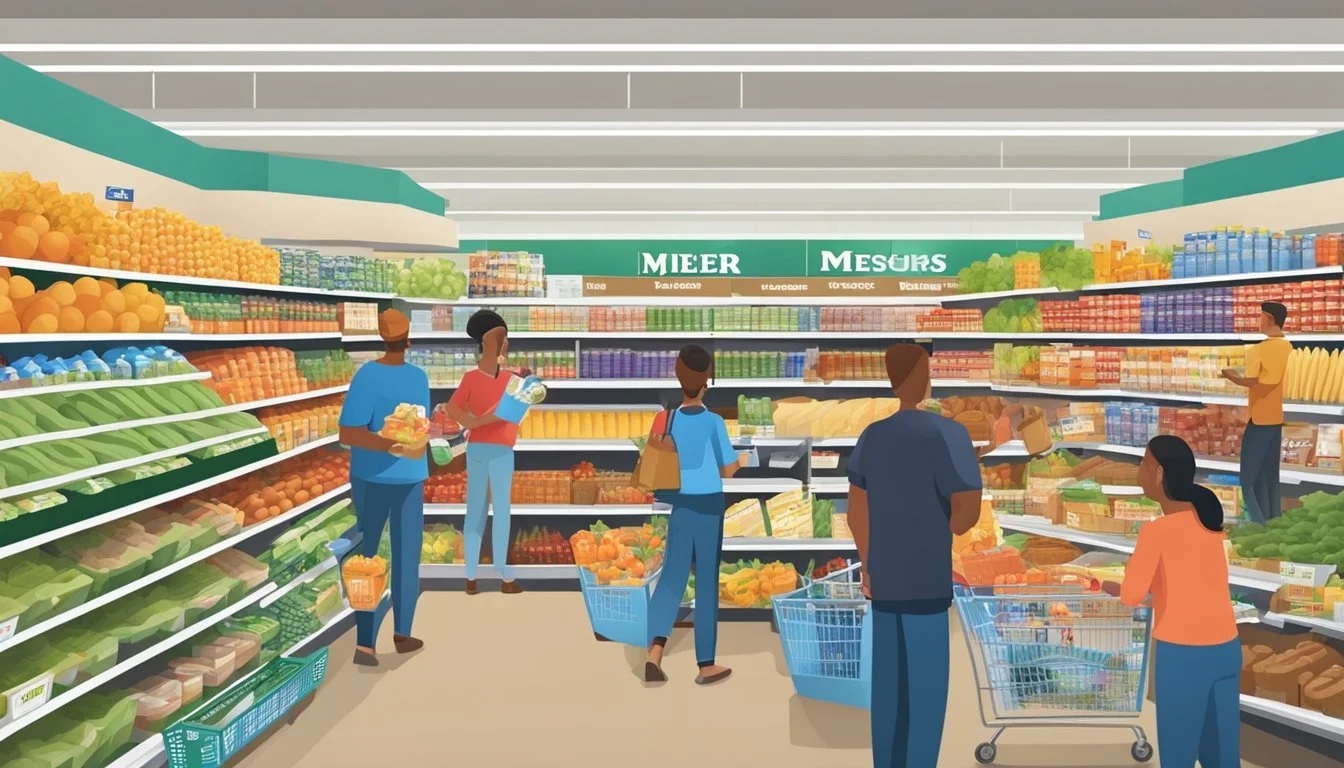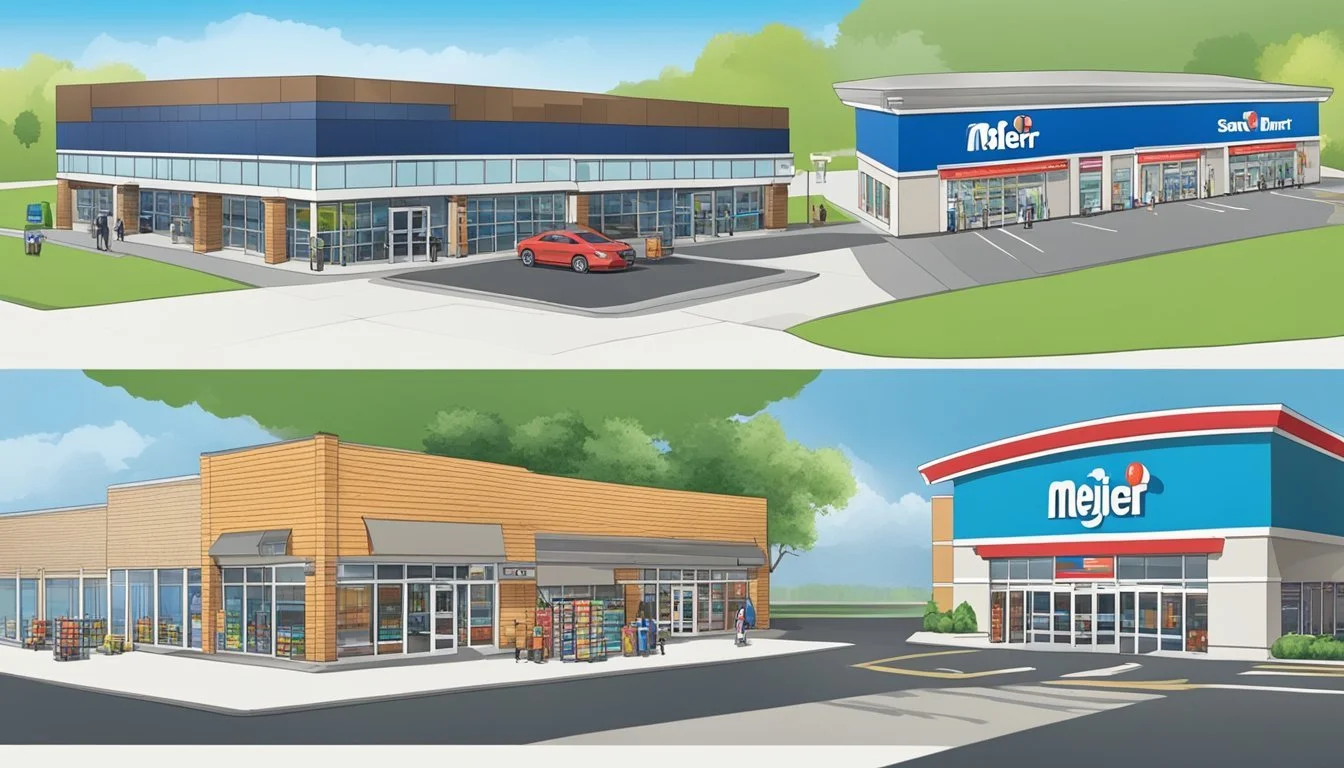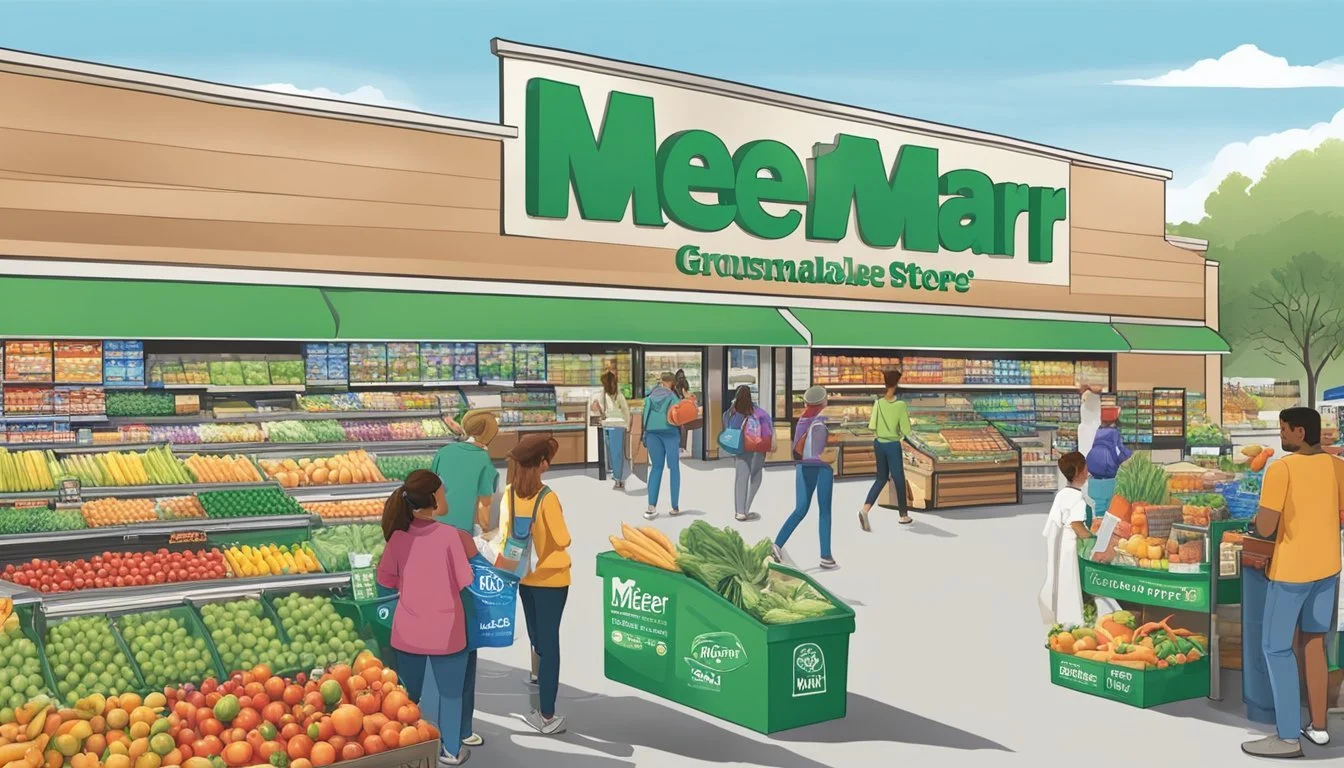Meijer vs Save Mart
A Comprehensive Comparison of Prices, Selection, and Service
Grocery shopping is an essential part of everyday life, and choosing the right store can significantly impact your budget and shopping experience. Meijer and Save Mart are two popular grocery chains that cater to different regions of the United States.
While both stores offer a wide range of products, they have distinct characteristics that set them apart. Meijer tends to have lower prices overall, with potential savings of up to 11% compared to average supermarket prices. This price difference can add up to substantial annual savings for regular shoppers.
Save Mart Supermarkets, on the other hand, focuses on providing a more localized shopping experience with a emphasis on fresh produce and regional products. The choice between these two retailers ultimately depends on individual preferences, location, and budget considerations.
Overview of Meijer and Save Mart
Meijer is a regional supermarket chain based in the Midwest United States. Founded in 1934, it has grown to operate over 250 stores across six states.
Save Mart is a regional grocery chain primarily located in California and Nevada. Established in 1952, it has expanded to include over 200 stores under various banners.
Both companies offer a wide selection of groceries, household goods, and national brands. Meijer utilizes a supercenter concept, combining groceries with general merchandise in large-format stores.
Save Mart focuses on traditional supermarket formats, with some locations featuring expanded departments like bakeries and delis.
Meijer stores are typically larger, averaging 150,000-250,000 square feet. Save Mart locations are generally smaller, ranging from 30,000-60,000 square feet.
Key differences:
Geographic focus: Meijer (Midwest) vs. Save Mart (West Coast)
Store format: Meijer (supercenters) vs. Save Mart (traditional supermarkets)
Product range: Meijer (broader) vs. Save Mart (grocery-centric)
Both chains emphasize fresh produce, competitive pricing, and customer service. They face competition from national chains and discount retailers in their respective markets.
Evaluation of Shopping Experience
Meijer and Save Mart offer distinct shopping experiences, with differences in their store layouts, customer service approaches, and checkout processes. These factors significantly impact customer satisfaction and convenience.
Store Layout and Design
Meijer stores typically feature a supercenter format, combining groceries with general merchandise. The layout is spacious and well-organized, facilitating easy navigation. Wide aisles accommodate shopping carts comfortably, reducing congestion during busy hours.
Save Mart focuses primarily on groceries, with a more compact store design. Their layout emphasizes efficiency, with clearly marked departments and logical product placement. This design can make quick trips more convenient for shoppers looking to grab essentials.
Both retailers prioritize cleanliness and maintain well-lit environments. Meijer often includes additional amenities like in-store pharmacies and garden centers, while Save Mart concentrates on creating an inviting produce section as a focal point.
Customer Service Quality
Meijer places a strong emphasis on customer service, training staff to be knowledgeable and helpful. Employees are generally easy to locate throughout the store, ready to assist with product inquiries or locating items.
Save Mart also values customer service, though their approach may be more focused on efficiency. Staff members are trained to be courteous and responsive, particularly at service counters and checkout areas.
Both retailers strive to maintain short wait times for assistance. Meijer's larger format may sometimes result in longer walks to find help, while Save Mart's more compact layout can make it easier to quickly locate staff when needed.
Checkout and Payment Efficiency
Meijer offers a variety of checkout options, including traditional lanes, self-checkout kiosks, and sometimes mobile checkout for smaller purchases. Their systems are generally up-to-date, supporting various payment methods including contactless options.
Save Mart focuses on efficient checkout processes, often featuring express lanes for customers with fewer items. They too offer self-checkout options in many locations, catering to shoppers who prefer a quicker exit.
Both retailers aim to minimize wait times during peak hours by opening additional lanes as needed. Meijer's larger stores may have more lanes available overall, potentially reducing congestion during busy periods. Save Mart's smaller footprint might lead to slightly longer lines at times, but their focus on grocery essentials can result in faster average transaction times.
Assortment and Product Selection
Meijer and Save Mart offer diverse product selections to meet various customer needs. Both stores stock a wide range of groceries, though their assortments differ in key areas.
Fresh Produce and Meat Quality
Meijer emphasizes fresh produce, featuring a farmers market-style layout with an extensive organic selection. Their produce departments often carry unique fruits and vegetables alongside staple items. Meijer's meat counters provide high-quality cuts and a variety of poultry options.
Save Mart also prioritizes fresh produce, though their selection may be more regionally focused. They partner with local farms to offer seasonal fruits and vegetables. Save Mart's meat department includes both pre-packaged and butcher-cut options to cater to different preferences.
Both stores maintain high standards for produce and meat quality, with regular rotations to ensure freshness.
Availability of Dry Goods and Dairy
Meijer stocks a comprehensive range of dry goods, including national brands and their own private label products. Their aisles feature an array of pasta, grains, canned goods, and baking supplies. Meijer's dairy section is well-stocked with milk, cheese, yogurt, and specialty items.
Save Mart offers a solid selection of dry goods, focusing on popular brands and regional favorites. Their dairy department includes standard milk and cheese options, as well as lactose-free and plant-based alternatives.
Both stores provide organic and specialty dietary options in their dry goods and dairy sections, catering to various nutritional needs.
Variety in Frozen Foods and Deli
Meijer's frozen food section is extensive, featuring a wide range of ready-to-eat meals, frozen vegetables, and desserts. Their deli department offers prepared foods, including rotisserie chickens, salads, and hot meal options.
Save Mart's frozen food aisle stocks popular brands and budget-friendly options. Their deli section provides sliced meats and cheeses, along with a selection of prepared foods and grab-and-go meals.
Both stores carry vegetarian and vegan frozen options, though Meijer typically offers a broader variety. Deli selections at both chains include party platters and catering services for special events.
Comparative Price and Value Analysis
Meijer and Save Mart employ distinct pricing strategies and offer various ways for customers to save money on groceries. These approaches impact the overall value shoppers receive at each store.
Everyday Prices and Discounts
Meijer maintains competitive pricing on a wide range of products. The store often features lower prices on beverages and dry goods compared to some competitors. Meijer also utilizes a "loss leader" strategy, offering deep discounts on select items to attract customers.
Save Mart focuses on providing value through consistently low prices across departments. The store emphasizes affordable pricing on fresh produce and meat. Save Mart's private label products offer additional savings opportunities for budget-conscious shoppers.
Both stores run weekly sales and promotions. Meijer typically has a larger number of sale items each week. Save Mart tends to offer longer-lasting discounts on staple items.
Loyalty Programs and Special Offers
Meijer's mPerks program allows customers to earn rewards points on purchases. These points can be redeemed for discounts on future shopping trips. The program also provides personalized coupons and exclusive deals to members.
Save Mart's digital rewards program offers similar benefits. Members receive tailored coupons and can accumulate points for savings. The store frequently runs digital-only promotions accessible through its mobile app.
Both retailers provide additional savings through their respective mobile apps. These apps feature digital coupons, exclusive offers, and the ability to create shopping lists based on current sales.
Meijer and Save Mart both offer fuel rewards programs. Customers can earn discounts on gas purchases based on their grocery spending. This added value extends savings beyond the grocery aisles.
Additional Amenities and Services
Meijer and Save Mart offer various supplementary services beyond groceries. These include health-related resources, home and electronics departments, and outdoor living solutions.
Pharmacy and Health Services
Meijer provides full-service pharmacies in most locations. Customers can fill prescriptions, receive vaccinations, and access wellness resources. The pharmacies offer medication consultations and health screenings. Save Mart also operates in-store pharmacies at select locations, though their services may be more limited.
Meijer's pharmacy services include:
Prescription refills
Immunizations
Medication therapy management
Health screenings
Save Mart pharmacies typically offer:
Prescription filling
Basic health advice
Limited vaccinations
Home and Electronics Department
Meijer features extensive home and electronics sections, resembling a department store. Customers can find appliances, kitchenware, bedding, and tech gadgets. The electronics department stocks televisions, computers, and gaming systems.
Save Mart generally focuses on groceries and household essentials. Their home goods selection is usually limited to basic kitchen items and small appliances. Electronics offerings at Save Mart are minimal, typically including only small gadgets or accessories.
Garden Center and Auto Care
Meijer operates seasonal garden centers with a wide range of plants, tools, and outdoor living products. Many locations also include basic auto care services and products. Customers can purchase car batteries, motor oil, and windshield wipers.
Save Mart does not typically offer dedicated garden centers or auto care services. Some stores may stock a small selection of seasonal plants or basic car maintenance items, but these are not primary focus areas for the chain.
Accessibility and Convenience
Meijer and Save Mart offer different shopping options to cater to customer needs. Their store locations, operating hours, and digital services impact overall convenience for shoppers.
Store Locations and Hours
Meijer operates over 250 supercenters primarily in the Midwest, with stores in Michigan, Ohio, Indiana, Illinois, Kentucky, and Wisconsin. Most Meijer locations are open 24 hours a day, 364 days a year, closing only on Christmas Day.
Save Mart has a more regional presence with around 200 stores in California and Nevada. Their hours vary by location but typically range from 6 AM to 11 PM or midnight, with some stores open 24 hours.
Meijer's wider geographic spread and round-the-clock availability give it an edge in accessibility for Midwest shoppers. Save Mart focuses on serving specific West Coast markets with convenient neighborhood locations.
Online Shopping and Delivery Services
Both chains have embraced e-commerce to enhance convenience. Meijer offers home delivery and curbside pickup through its Meijer app and website. Customers can choose from over 100,000 items for same-day delivery in as little as one hour.
Save Mart provides online ordering and delivery through third-party services like Instacart in select areas. Their ClickCart program allows customers to order groceries online for curbside pickup at participating stores.
Meijer's integrated digital platform and wider delivery coverage make it more convenient for online shoppers. Save Mart's e-commerce options, while more limited, still offer flexibility for local customers seeking alternatives to in-store shopping.
Community Impact and Sustainability
Meijer and Save Mart both prioritize community engagement and environmental responsibility. Their efforts extend beyond retail operations to positively influence local economies and promote sustainable practices.
Local and National Economic Contribution
Meijer operates over 250 stores across six Midwestern states, creating thousands of jobs. The company's expansion has contributed significantly to economic growth in these regions. Meijer invests in local communities through partnerships with food banks and support for education initiatives.
Save Mart, with around 200 stores in California and Nevada, also plays a vital role in local economies. The company emphasizes hiring from nearby communities and collaborates with regional suppliers. This approach strengthens local business networks and stimulates job creation.
Both retailers contribute to national economic growth through their supply chains and distribution networks. Their operations support numerous indirect jobs in transportation, manufacturing, and agriculture sectors across the US.
Sustainability Practices and Initiatives
Meijer has set ambitious sustainability goals, aiming to divert 70% of company waste from landfills by 2025. In 2022, they achieved approximately 66% waste diversion. The company has implemented recycling programs and partners with local organizations to repurpose materials.
Meijer's sustainability efforts include:
Food waste reduction initiatives
Energy-efficient store designs
Sustainable packaging solutions
Save Mart focuses on reducing its environmental footprint through various eco-friendly practices. These include:
Energy-efficient lighting and refrigeration systems
Recycling programs for cardboard and plastics
Promotion of reusable bags to reduce single-use plastic waste
Both companies have increased their offerings of organic and locally-sourced products, supporting sustainable agriculture practices. They also work to minimize transportation emissions by optimizing delivery routes and using fuel-efficient vehicles.
Conclusion and Final Thoughts
Meijer and Save Mart both offer unique shopping experiences for grocery consumers. Meijer's wide product selection and competitive pricing on certain items make it an attractive option for many shoppers.
Save Mart excels in its focus on fresh, locally-sourced produce and commitment to supporting regional farmers. This approach appeals to customers who prioritize quality and community connection in their grocery choices.
Pricing strategies differ between the two chains. Meijer often provides better value on beverages and dry goods, while Save Mart may offer competitive prices on fresh items.
Store layouts and atmospheres vary, with Meijer typically featuring larger supercenters and Save Mart maintaining a more traditional grocery store feel. This can influence the overall shopping experience for customers.
The choice between Meijer and Save Mart ultimately depends on individual preferences and priorities. Shoppers seeking a one-stop destination for a wide range of products may lean towards Meijer.
Those who value fresh, local produce and a more intimate shopping environment might prefer Save Mart. Considering factors such as location, product availability, and personal budget can help consumers make an informed decision.










